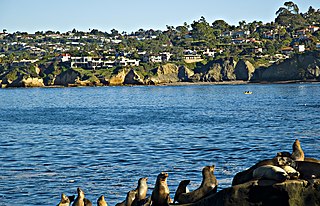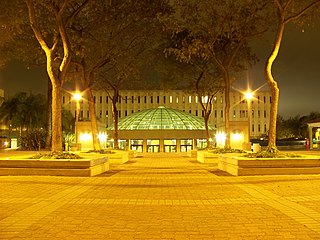
The Scripps Institution of Oceanography, located in San Diego, California, is one of the oldest and largest centers for ocean and Earth science research in the US. Originally founded in 1903, since becoming part of the University of California system in 1912, the institution has expanded its scope to include studies of the physics, chemistry, geology, biology, and climate of Earth.

San Diego State University (SDSU) is a public research university in San Diego, California. Founded in 1897 as San Diego Normal School, it is the third-oldest university and southernmost in the 23-member California State University (CSU) system. In Fall 2022, SDSU hit an all time high enrollment record student body of nearly 37,000 and an alumni base of more than 300,000.

The Moss Landing Marine Laboratories (MLML) is a multi-campus marine research consortium of the California State University System, headquartered at Moss Landing, California.

The Southern California Bight is a 692-kilometer-long stretch of curved coastline that runs along the west coast of the United States and Mexico, from Point Conception in California to Punta Colonet in Baja California, plus the area of the Pacific Ocean defined by that curve. This includes the Channel Islands of California and the Coronado Islands and Islas de Todo Santos of Baja California.
The San Diego State University College of Sciences is the San Diego region's largest center for science education and research. Comprising eight departments and various specialties, the College offers bachelor's, master's and doctoral degrees, as well as curricula for pre-professional students in medicine, veterinary medicine and dentistry. The College strives to produce scientifically educated graduates who possess both a fundamental understanding of their fields and the essential professional skills needed by local and regional industries. The College provides scientific literacy for all San Diego State University graduates as well as participating in the training of future mathematics and science teachers.
San Diego State University College of Engineering provides San Diego State University students with undergraduate and graduate engineering education. The College of Engineering offers eight degree programs. The Aerospace Engineering, Civil Engineering, Computer Engineering, Electrical Engineering, Environmental Engineering, Mechanical Engineering, and Construction Engineering programs are accredited by the Engineering Accreditation Commission of ABET.
The San Diego State University College of Health and Human Services faculty, through advising, teaching, and supervising, offers students academic study, field placement, clinical experiences, and research opportunities. The College offers professional education in the health and human service disciplines. The College consists of the following group of professional schools, and departments: the School of Speech, Language, and Hearing Sciences, the School of Nursing, the School of Social Work, the Department of Gerontology, and the Graduate School of Public Health.


Point Loma is a seaside community within the city of San Diego, California, United States. Geographically it is a hilly peninsula that is bordered on the west and south by the Pacific Ocean, the east by the San Diego Bay and Old Town, and the north by the San Diego River. Together with the Silver Strand / Coronado peninsula, the Point Loma peninsula defines San Diego Bay and separates it from the Pacific Ocean. The term "Point Loma" is used to describe both the neighborhood and the peninsula.

The Virginia Institute of Marine Science (VIMS) is one of the largest marine research and education centers in the United States. Founded in 1940, VIMS is unique among marine science institutions in its legal mandate to provide research, education, and advisory services to government, citizens, and industry. Funding for VIMS comes from the Commonwealth of Virginia, grants and contracts from federal and state agencies, and private giving. The School of Marine Science (SMS) at VIMS is the graduate school in marine science for the College of William & Mary. VIMS offers M.S., Ph.D., and professional M.A. degrees in marine science. The school has 52 faculty members, an enrollment of 80-100 students, and includes 4 academic departments. VIMS' main campus is located in Gloucester Point, Virginia.

The California Institute for Telecommunications and Information Technology (Calit2, previously Cal(IT)2), also referred to as the Qualcomm Institute (QI) at its San Diego branch, is a $400 million academic research institution jointly run by the University of California San Diego (UC San Diego) and the University of California, Irvine (UCI); in January 2022, plans were announced to add University of California, Riverside to the consortium. Calit2 was established in 2000 as one of the four UC Gray Davis Institutes for Science and Innovation. As a multidisciplinary research institution, it is conducting research discovering new ways in which emerging technologies can improve the state's economy and citizens' quality of life. Keeping in mind its goal of addressing large-scale societal issues, Calit2 extends beyond education and research by also focusing on the development and deployment of prototype infrastructure for testing new solutions in real-world environments. Calit2 also provides an academic research environment in which students can work alongside industry professionals to take part in conducting research and prototyping and testing new technologies.

Malcolm A. Love Library, opened in 1971, is the primary, central academic library serving multiple campuses of San Diego State University (SDSU) in Southern California and Northern Baja California, Mexico. Located on the Montezuma Mesa in the College Area of San Diego, California, the library underwent a major expansion to improve Library & Information Access for students institution-wide with construction of the Manchester Hall addition including a spectacular glass enclosed atrium to serve as the new entrance gateway for the University Library. The iconic design and architecture of the new glass and steel enclosed lobby, and its stated purpose, has earned the entire complex the reference The Info Dome.
The Aztec Aquaplex, located on the San Diego State University (SDSU) campus in San Diego, California, USA. The facility is operated and managed by the Associated Students of San Diego State University, which sells passes for access.

The Midway area, also referred to as the North Bay area, is a neighborhood of San Diego, California. It is located at the northern (mainland) end of the Point Loma peninsula, northwest of Downtown San Diego and just west of Old Town. It is often considered to be part of Point Loma, although the city treats it as a separate Planning Area.

Tijuana River National Estuarine Research Reserve is a natural reserve in Imperial Beach, California and San Ysidro, San Diego. It encompasses the Tijuana River Estuary, located on the Mexico–United States border. It is divided into two parts: the Tijuana Slough National Wildlife Refuge on the north, and Border Field State Park in the south.
The Southern California Coastal Water Research Project (SCCWRP) is a research institute focusing on the coastal ecosystems of Southern California from watersheds to the ocean. SCCWRP was created as a joint powers authority (JPA), which is an agency formed when multiple government agencies have a common mission that can be better achieved by pooling resources and knowledge. The purpose of SCCWRP is to gather the necessary scientific information to allow member agencies to effectively and cost-efficiently steward the Southern California coastal environment.
San Diego-Scripps Coastal Marine Conservation Area (SMCA) and Matlahuayl State Marine Reserve (SMR) are adjoining marine protected areas that extend offshore from La Jolla in San Diego County on California’s south coast. The two marine protected areas cover 2.51 square miles. San Diego-Scripps Coastal SMCA prohibits the take of all living marine resources except that coastal pelagic species, not including market squid, may be taken recreationally by hook and line. Matlahuayl SMR prohibits the take of all living marine resources.

Exequiel Ezcurra is an Argentine-Mexican plant ecologist and conservationist. His highly interdisciplinary work spans desert plant ecology, mangroves, island biogeography, sea birds, fisheries, oceanography, and deep-sea ecosystems.

Susan Lynn Williams was an American marine biologist and Distinguished Professor of Evolution and Ecology at the University of California, Davis, where she directed the Bodega Marine Laboratory from 2000-2010. She researched marine coastal ecosystems and how they are affected by human activities. She was a strong advocate for environmental protection, credited with helping pass legislation expanding the boundaries of Northern California's Gulf of the Farallones and Cordell Bank national sanctuaries, increasing the area of federally-protected coastal waters.
Joy Buswell Zedler is an American ecologist and professor of botany at the University of Wisconsin–Madison (UW), holding the title of Aldo Leopold Chair of Restoration Ecology. In addition to restoration ecology, she specializes in the ecology of wetlands, rare species, interactions between native and introduced species, and adaptive management.














